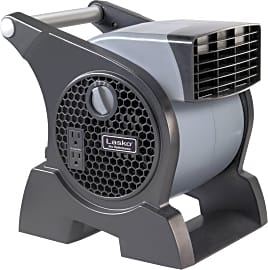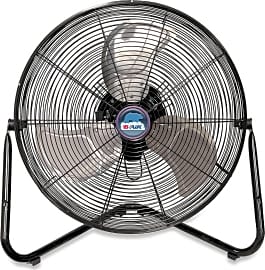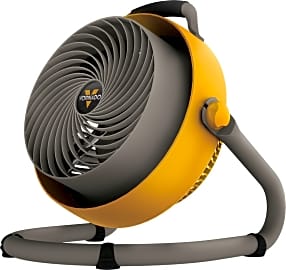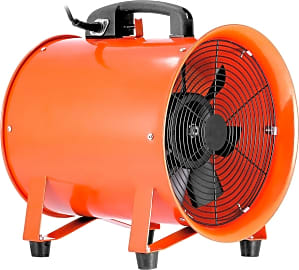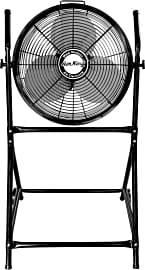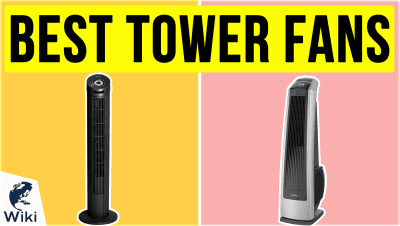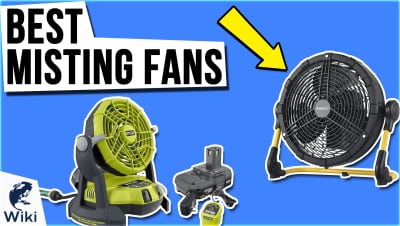The 9 Best High Velocity Fans

This wiki has been updated 42 times since it was first published in June of 2015. If you don't have air conditioning in your shop or your garage is just too hot, cool things down a touch with a strong fan that can generate a high velocity breeze and allow you to continue working in comfort. Check out our comprehensive selection that includes drum models ideal for ventilating large spaces as well as some specially designed for drying freshly cleaned or painted surfaces. When users buy our independently chosen editorial recommendations, we may earn commissions to help fund the Wiki.
Editor's Notes
July 06, 2019:
In this list, we've included heavy-duty models that are ideal for large workshops, in addition to a compact desktop option. They're all guaranteed to circulate air more effectively than a standard fan, which should come as a relief during summer days when the air indoors begins to get a bit stale and uncomfortable. In fact, some of these powerful fans can move several thousand cubic feet of air per minute. You'll also notice that many have other useful features such as timers, wheels, and multiple speed settings.
With regard to changes, the Ozeri Brezza III has been removed due to its being markedly less powerful than most high velocity fans. The Patton PUF1810C has been promoted to the number one spot because of its simple design and overwhelmingly positive reviews.
Ventilation And Circulation For Safety And Comfort
Good ventilation and air circulation are imperative for safety, as well.
Proper ventilation is a requisite for interior comfort, but its importance also goes beyond mere comfort alone. Good ventilation and air circulation are imperative for safety, as well. Regardless of whether you are working, exercising, cooking, or sleeping, you need to breathe clean, fresh air at all times. That means that an interior space must have decent airflow provided by an HVAC system, a cross breeze from an open window, or air circulated by fans.
Stagnant air can lead to higher concentrations of particulate pollution, and while many fine particles floating in the air may be too small to see, over time these bits of mold, dust, and pollen will have a negative impact on your health. In fact, indoor air quality (often abbreviated as IAQ) is often much poorer than the outside air just beyond the windows and doors. Circulating interior air is an important step in reducing issues of interior air quality.
Proper air circulation is especially important for busy factories, worksites, garden centers, or artisans's studios. When large amounts of dust and debris are being created by saws slicing through wood or grinders working on metals, or based on the powdered materials lying around like concrete, fertilizer, and the like, the air has to be kept clean. A good HVAC system with proper (and regularly cleaned) filters is important, but often this system must be aided by the addition of powerful, high velocity fans.
Even when a worksite is largely open to the outdoors, such as an auto body shop with large bay-style doors or with a home or building being framed, stagnant air can be an issue. Powerful fans can keep air moving both to clear contaminants from the air and also to keep workers cooler while they undertake physically strenuous labor. And remember that a fan has at least one distinct benefit over even the best air conditioning system: portability. You can move a fan about a shop, gymnasium, home, or construction site as needed, drying paint, cooling workers, and keeping the air moving.
Choosing A High Velocity Fan For Commercial Use
A high velocity fan is an asset for many types of professional work. The most common place you will see a large, powerful, high velocity fan being used is at a construction site. These fans can keep air moving around a house being framed, a building being erected, or a retail space or restaurant being renovated. High velocity fans are important for use in these sites largely because they can help keep the workforce cooler and more comfortable as the team performs laborious tasks. But such fans are also vital for helping dry caulk, grout, or paint, and for preventing sawdust and other particles in the surrounding air from being inhaled.
These fans can keep air moving around a house being framed, a building being erected, or a retail space or restaurant being renovated.
High velocity fans are also an important tool for those working in carpet cleaning or contaminant abatement. After carpet cleaning or after the removal of water caused by a flood, a high velocity fan (or, more often, a group of such fans working in tandem) can be used to rapidly increase the drying of flooring, walls, and ceilings.
In fact, using good high velocity fans can prove to be the difference between a carpet or section of wall that is properly dried and salvaged after a flood and materials that need to be replaced at a much greater cost. For use in such applications, it's important to choose a fan that can be easily directed, and ideally one that sits low to the ground.
Many high velocity fans are purpose-built to blow air across the ground, and these are always the best choice for drying carpets and flooring. Note that the heat created by some such fans may actually increase the overall temperature of a space more than they lower it, though. This is only an issue if the area is occupied during the drying and is already on the warmer side.
For general circulation of air around a workspace, factory, or large shop, a drum-style, high velocity fan is usually the best choice. These fans can move a large volume of air over a great distance, helping to create the circular movement of air that provides ideal interior ventilation and helps create an even temperature throughout a workspace. Do consider the noise created by various options, as some high velocity fans can be quite loud and may markedly increase the din of an already noisy area.
Choosing A High Velocity Fan For Everyday Applications
High velocity fans are a mainstay of high school gymnasiums everywhere, and for good reason: they move enough air to keep people cooler even in cavernous spaces like a gym. And if a decent fan can cool an entire gym filled with people engaged in active sports, it can certainly help cool down everything from an art studio to a retail shop or your own home.
One of the best ways to use a high velocity fan, however, is actually to set it up outdoors. A strong high velocity fan can be set well back from your porch or patio, lessening the issues created by their loud noise output. The fan will still create plenty of breeze to cool you down and to blow away most insects, especially mosquitoes, who are notoriously weak flyers. This all translates to an outdoor space that's both more comfortable and safer, as well.
It's also not a bad idea to keep a high velocity fan in the garage or attic even if you think you'll rarely use it: many decent high velocity fans are affordable enough to keep on hand for those rare times when the AC goes out or for when a bad spill merits some serious drying.



